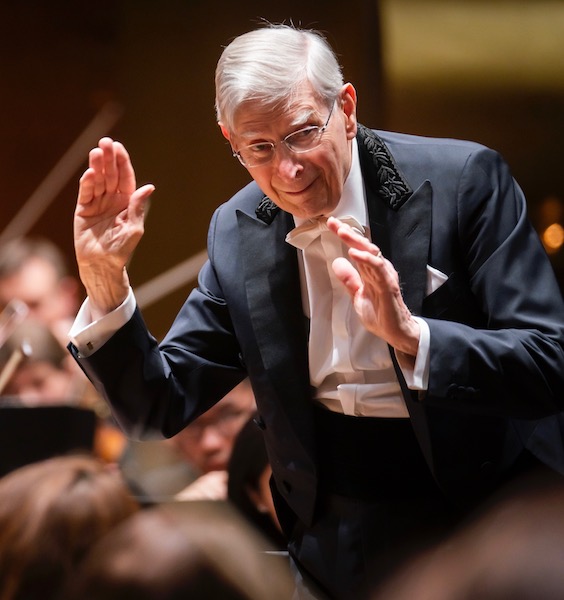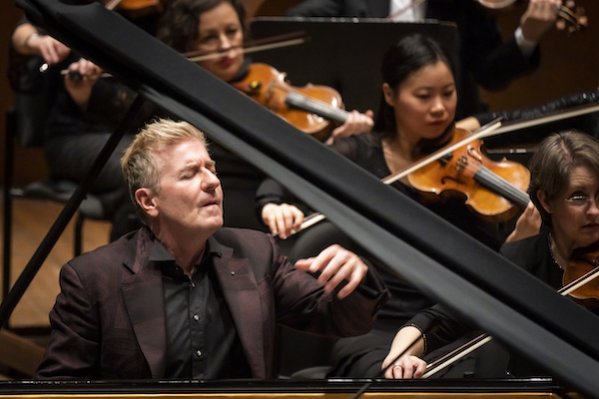Dynamic Dvořák and less-great Grieg from Blomstedt, Philharmonic

Herbert Blomstedt conducted the New York Philharmonic Thursday night at David Geffen Hall. Photo: Chris Lee
A couple years ago, when Alan Gilbert and the New York Philharmonic opened their season with a memorable performance of Dvořák’s Symphony No. 9, a critic wrote in his notebook, “Phil. owns this piece.” Thursday night, on fire with insight and esprit de corps under Herbert Blomstedt’s direction, the orchestra added the Czech composer’s Eighth Symphony to its asset portfolio.
Long patronized as the folksy, friendly sibling to the mighty “New World,” the Eighth revealed its greatness Thursday night—especially in the central Adagio, composed with Beethoven-like daring and compellingly realized from first bar to last by Blomstedt and his players.
The long movement can seem puzzling and disjointed, as dramatic surges alternate with moments of stasis, but on Thursday the performers sensed the emotional impulse that drives it all, even as they vividly rendered each episode. These few minutes even approached a kind of symphonic ideal.
The other movements were no less compelling. The opening Allegro con brio flowed strongly with its abundance of themes, crisp or swoony as the moment demanded, the large orchestra turning on a dime through the many changes of tempo. The excitingly layered, fugal development was a disciplined storm.
Conductor Blomstedt, spry at 91, led without a baton and with curving, embracing arm gestures. But there must have been some smart cues hidden in those mild motions, since the orchestra was on its mettle every step of the way.
In the waltz-scherzo movement, the orchestra achieved a Tchaikovsky-like blend of silky strings over burbling woodwinds, while keeping a grounded feeling essential to Dvořák.
Scrupulously observing the finale’s Allegro ma non troppo marking, Blomstedt launched the exuberant main theme at a brisk but not hectic pace, the better to pounce later with the thrilling Più mosso coda. Every transformation of the theme was soaked with character, from the cellos’ courtly opening gavotte to the deep nostalgia of the soft strings later on.
Perfection, of course, always eludes us. On Thursday the flute’s brilliant solo in the finale came a-cropper, and the Philharmonic horns, chronically too loud, did their thing again, nearly blotting out the cellos’ theme that opens the symphony. But these were small bumps in a profoundly inspiring road.

Jean-Yves Thibaudet performed Grieg’s Piano Concerto Thursday night. Photo: Chris Lee
The concert’s all-Grieg first half gave few hints of the riches to follow. The Peer Gynt Suite No. 1 is no great test of an orchestra’s artistic depth, but its four brief, colorful movements deserve better than the offhand treatment they received Thursday. The familiar strains of “Morning Mood” wavered in tempo, and the tune’s little swells felt pushed rather than natural.
The muted strings descended skillfully through layers of pianissimo in “Åse’s Death,” but the tension of grief was missing. The slithery “Anitra’s Dance” sounded prosaic, unlikely to seduce anybody, but at least the triangle kept everybody in time. Grieg, the admirer of Schumann and aspiring symphonist, was embarrassed by the corny tune of “In the Hall of the Mountain King,” but Thursday’s performance gave it some flash and an exciting accelerando.
Jean-Yves Thibaudet was the poised soloist in Grieg’s Piano Concerto, inspired by Schumann’s work in the same genre but liberally dosed with Lisztian hot sauce. At the outset, the orchestra answered the piano’s craggy cadenza with rather weak playing, out of time. Thibaudet seemed to catch that bug as well, his tone strong in forte but going flabby in piano, his tempo steady in chordal passages but tending to rush in the fingery bits. His long solo cadenza, however, was effectively dreamy and flashy by turns, and the movement’s craggy close matched, then exceeded its opening.
Muted strings phrased ripely in the very slow Adagio—at least one thinks they did, since they were “accompanied” by horns. The soloist’s later proclamation of the theme in big chords was broad and beautiful, and led to some fine dialogue between piano and woodwinds.
As so often happens, a high-octane finale came to the rescue of a mixed concerto performance. There was no tentativeness of tempo as the finale’s fast main theme stepped out smartly, then smoothly shifted gears for the languid second theme in flute, then piano. The soloist’s tone projection in piano and pianissimo passages got stronger, as if buoyed by the movement’s underlying energy. The first theme’s Beethovenesque transformation in the coda, up-tempo and three-to-a-bar, was a frothy delight, and the concerto’s grand closing peroration brought the audience to its feet.
The program will be repeated 8 p.m. Friday and Saturday. nyphil.org; 212-875-5656.